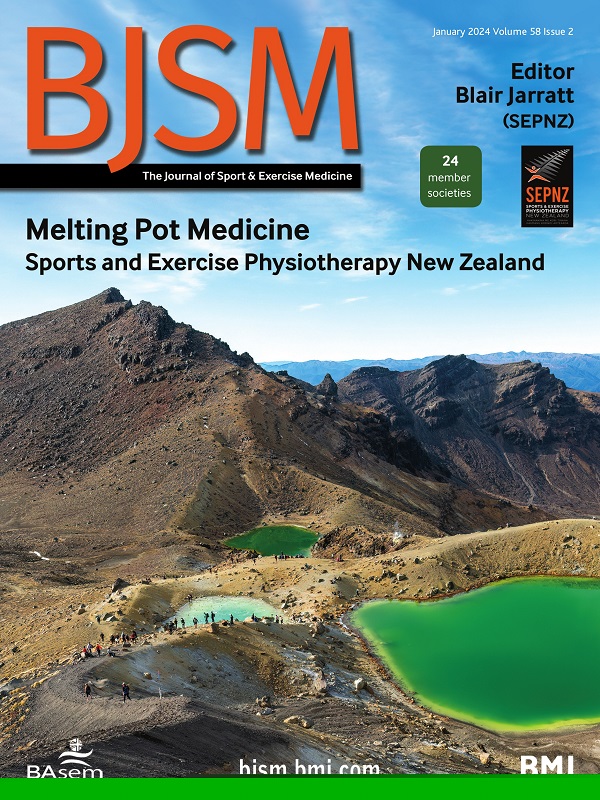Thermoregulation and dehydration in children and youth exercising in extreme heat compared with adults
IF 16.2
1区 医学
Q1 SPORT SCIENCES
引用次数: 0
Abstract
Objective To compare hyperthermia and physiological dehydration risk during exercise heat stress between children of different ages and adults and evaluate an existing adult sweat rate calculator in children. Methods 68 fit and recreationally active children aged 10–16 years (31 girls), and 24 adults aged 18–40 years (11 females) completed three separate 45 min treadmill walking/running trials at different intensities on different days at 30°C, 40% relative humidity (RH) (WARM) or 40°C, 30% RH (HOT). Exposures were randomised to elicit intensities scaled to (1) fitness, (2) mass and (3) surface area. Core (gastrointestinal (Tgi)) temperature was measured continuously and dehydration determined using body mass changes. Results Except for 60% V̇O2peak in WARM, in which adults exhibited a greater Tgi rise compared with 10–13 years, there was no effect of age on Tgi during exercise (p≥0.176). Physiological rates of dehydration were not affected by age in WARM (p≥0.08) or HOT (p≥0.08). Mean predicted sweat rate error was +0.08 kg/hour (95% CIs: −0.10, +0.25) across WARM and HOT, and 80.5% of variability in sweating was explained by the adult sweat rate calculator. Conclusions Using the most comprehensive paediatric exercise heat stress dataset from a single study to date, we show that children aged 10–16 years are at a similar risk of hyperthermia and dehydration as adults during exercise up to 40°C. This supports recent changes to paediatric sport heat policies that were based on limited data. Practitioners can potentially reduce behavioural dehydration risks from inadequate fluid consumption using an existing adult sweat rate calculator for children. Data are available on reasonable request. Permission for reuse of data must be obtained in writing from the corresponding author.与成人相比,儿童和青少年在极端高温下运动的体温调节和脱水
目的比较不同年龄儿童和成人在运动热应激时的热休克和生理性脱水风险,并对现有的成人儿童出汗率计算器进行评价。方法68名10-16岁的健康儿童(31名女孩)和24名18-40岁的成年人(11名女性)分别在30°C、40%相对湿度(WARM)和40°C、30%相对湿度(HOT)条件下,在不同的日期、不同强度的跑步机上进行45分钟步行/跑步试验。暴露是随机的,以引出按(1)适应性,(2)质量和(3)表面积缩放的强度。连续测量核心(胃肠道)温度,并通过体重变化确定脱水情况。结果除了成人在WARM期出现60%的峰值时Tgi升高幅度大于10-13岁外,年龄对运动时Tgi没有影响(p≥0.176)。在WARM组(p≥0.08)和HOT组(p≥0.08),生理脱水率不受年龄的影响。在WARM和HOT中,平均预测出汗率误差为+0.08 kg/h (95% ci:−0.10,+0.25),80.5%的出汗变异性可以用成人出汗率计算器解释。使用迄今为止单一研究中最全面的儿科运动热应激数据集,我们表明10-16岁的儿童在高达40°C的运动中与成人具有相似的高热和脱水风险。这支持了最近基于有限数据的儿科运动热政策的变化。从业人员可以使用现有的儿童成人出汗率计算器潜在地减少因液体摄入不足而导致的行为性脱水风险。如有合理要求,可提供资料。重复使用数据必须获得通讯作者的书面许可。
本文章由计算机程序翻译,如有差异,请以英文原文为准。
求助全文
约1分钟内获得全文
求助全文
来源期刊
CiteScore
27.10
自引率
4.90%
发文量
217
审稿时长
3-8 weeks
期刊介绍:
The British Journal of Sports Medicine (BJSM) is a dynamic platform that presents groundbreaking research, thought-provoking reviews, and meaningful discussions on sport and exercise medicine. Our focus encompasses various clinically-relevant aspects such as physiotherapy, physical therapy, and rehabilitation. With an aim to foster innovation, education, and knowledge translation, we strive to bridge the gap between research and practical implementation in the field. Our multi-media approach, including web, print, video, and audio resources, along with our active presence on social media, connects a global community of healthcare professionals dedicated to treating active individuals.

 求助内容:
求助内容: 应助结果提醒方式:
应助结果提醒方式:


